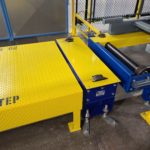Downloaded Preventive Maintenance Manual can be found here.
Preventive Maintenance
The basic tool preventive maintenance is visual inspection. During visual inspection, surfaces should be
cleaned, bolts should be checked for tightness/torque and equipment should be lubricated with the
correct amount of oil or grease.
The following provide guidelines for equipment inspection as well as standard maintenance
procedures
Lubrication Requirements
Gear Oil Lubrication
Table 5-1 lists the viscosity grade type gear oil lubricant the gearmotors in your system uses. Do not mix
oil grades when adding oil; use the fill oil of the previous grade. Refer to the manufacturer’s instruction
manual for additional service requirements and technical data.
| Part Description | Type of Gearing | Type of Oil | Mfgr Type | Viscosity/Grade |
| SEW Drive Units | Helical-Worm | Synthetic | Shell Omala S4-WE220 | ISO VG 220 |
| Bauer Gear Motor | Helical-Worm | Synthetic | Shell Omala S4-WE220 | PGLP 220 |
Data plates on the gearmotors typically identify the oil type and quantity that they use.
Bearing Grease Lubrication
The table below lists the recommended grease to use in bearings.
| Application Field | Type/Grade | Recommended Brands |
| Generic Bearings: Pillow, Flange, Roller | All Purpose/NGLI 2 | Mobil – Mobilux EP 2
Shell – Alvania EP 2 |
During a re-lubrication interval the old grease may be removed by purging with new grease. This can be
done initially and/or progressively by temporarily shortening the application interval and increasing the
quantity of grease applied. Purging old, hard, contaminated grease with new grease is advisable even if
the same grease brands are used to ensure that all parts of the equipment are actually receiving new
grease.
Sometimes, small openings in the grease-lubricated area become clogged with contaminates or old
grease and normal re-lubrication is not sufficient to distribute fresh lubricant to all parts of the element.
The potential for clogged passageways must be checked carefully (ensure some old grease is purged from
the bearing housing). After re-lubrication or purging of old grease, the equipment should be monitored
for signs of possible incompatibility such as grease leakage, abnormally high operating temperatures (if
equipment is not over-packed with grease), or noise.
Mechanical Preventive Maintenance Tables
This section contains preventive maintenance schedules with recommended lubrication intervals.
Assemblies in this section include:
– Roller Table
The Preventive Maintenance Table for each item name in the above list will typically span two pages. A
listing of the recommended maintenance operations is on one page, followed by a figure or schematic of
the equipment on the other.
- On the preventive maintenance table page, the first column reports the frequency (in months, exceptionally in weeks) required for the maintenance operation.
- The number in the second column is the Item Number of each part; that you can find in the callouts on the schematic drawing or figure that goes with that table.
- The third column contains the item name.
- The fourth column contains the required operation i.e. inspection or lubrication.
- The fifth column contains a detailed description of the operation to perform.
Daily Checks
Each day you should walk around the system and look for the following:
- Obvious signs of damage to the equipment.
- Damage or noticeable wear on the carrying and guide rollers.
- Signs of oil leaks on the equipment or on the floor below any gearbox.
If you notice any of the above issues, perform the necessary maintenance or repair immediately.
| Interval (Months) | Item No. | Item Name | Required Operation | Description |
| 3 | 1 | Carrying Roller | Inspection |
|
| 3 | 2 | Motor Drive Pulley | Inspection |
|
| 3 | 3 | Drive Toothed Belt | Inspection |
|
| 6 | 4 | Driven Toothed Belt(s) | Inspection |
|
| 6 | 5 | Gearmotor | Inspection |
|
| 36 | 5 | Gearmotor | Inspection |
|

